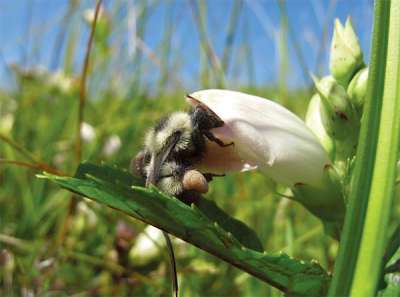We hear a great deal in the news about the decline of managed honeybee colonies, but little has been reported about the crisis facing native bumblebees. According to Leif Richardson, a University of Vermont postdoctoral researcher, more than a third of North America’s 50 bumblebee species are considered rare or endangered, and some of these species have experienced rapid declines in recent years.
Richardson focuses his research on how naturally produced chemicals in nectar and pollen affect bumblebees. He said that plants produce these chemicals in their leaves and other tissues as a defense against herbivory. And he hypothesized that the chemicals may benefit pollinators like bumblebees by providing an “antiparasite benefit.”
Parasites have been implicated as contributing to some bee declines, so Richardson inoculated newly emerged worker bees with a common parasite, Crithidia bombi, that lives in the gut of bumblebees, making the bees sick. He then fed half of the bees sugar-water laced with one of eight naturally occurring chemicals found in plant nectar, while the other half was fed a control diet. A week later, he counted the number of parasite cells in the bees and found that four of the chemicals – thymol from basswood tree nectar, catalpol from turtlehead flowers, and nicotine and anabasine from plants in the tobacco family – had a strong negative effect on the parasite. The other four chemicals also had a negative effect on the parasites, but not to the point of being statistically significant.
“We demonstrated pretty conclusively that bees can benefit from an enhanced diet of these nectar and pollen chemicals,” said Richardson. “We found that the chemicals had no effect on the survival of the bees, and the bees getting the chemicals had a lower parasite load.”
But his results made him wonder whether there were any longer-term consequences of consuming the chemicals, especially whether there were negative implications for bee reproduction. So he did another experiment focusing on anabasine, the chemical that had the strongest effect in the first experiment. This time he found that the chemical had no effect on the lifespan of the bees, but the bees did start laying eggs two days later than those not fed the chemical.
“Is a two-day delay a problem?”
Richardson wondered. “We’re unsure. It may depend on other factors, like available pollination resources and environmental conditions.”
“But these bumblebees are probably exposed to much higher concentrations and diversities of plant chemicals than those tested in our lab experiment,” he added. “So we probably underestimated the effects of the chemicals. We fed them only one chemical, but in the life of a bumblebee colony, they’re consuming a lot of pollen and nectar and eating a number of plant chemicals from different sources, so there could be even more benefits and costs.”
Based on his results and those of follow-up studies, Richardson says he may come up with recommendations for how farmers and land managers can expose bees to more of the beneficial chemicals and less of the harmful ones. “It may be that some bees are eating health food and others are eating more junk food,” he said.


